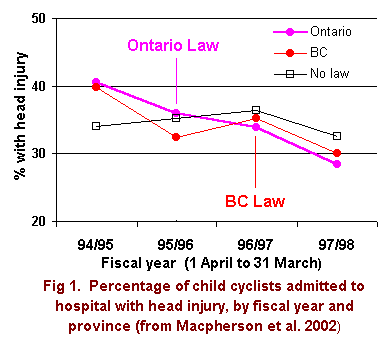
Impact of Mandatory Helmet Legislation on Bicycle-Related Head Injuries in Children: A Population-Based Study
Macpherson AK, To TM, Macarthur C, Chipman ML, Wright JG, Parkin PC. Pediatrics 2002;110(5):e60
Original paper 
Summary of original paper
The study compared rates of head injury to children (5 - 19 years) in regions throughout Canada with and without mandatory cycle helmet legislation. The sample size was 9,650, of whom 3,426 sustained injuries to the head and face and the remaining 6,224 had other injuries. The bicycle-related head injury rate declined by 45% in provinces where legislation had been adopted compared with 27% in other provinces and territories. The authors thus claim a strong protection association between helmet legislation and head injuries.
BHRF Commentary
An e-letter pointing out shortcomings in the paper was subsequently published by Pediatrics (Robinson, 2003b).
Read the full published critique here. 
Shortcomings include:
- In the two Canadian provinces (Ontario, British Columbia) representing 89% of the total data set for legislation provinces, most of the falls in head injuries took place before the laws came into effect. In British Columbia % head injury increased in the year following the law and then declined at a rate not significantly different to no-law provinces. In Ontario post-law the decline in % head injuries was also similar to non-law provinces. This suggests that trends, rather than helmet legislation, may have been responsible for the changes.
- Legislation provinces had significantly higher levels of head injuries and higher levels of helmet use pre-law than non-law provinces.
- The paper does not discuss coding methods and whether these were the same in all provinces and across time. Such changes would need to be controlled for. A subsequent report from Alberta () (a non-law province for this study, but which enacted legislation subsequently) suggested that changes in head injury coding did take place.
|
 |
In 2006, the same authors reviewed the law in Ontario and showed that helmet wearing had returned to pre-law (or below pre-law) levels by 2001 (Macpherson et al, 2006). Data from another source showed that, despite the reduction in helmet wearing, head injuries were still declining at a faster rate than non-head injuries (CIHI, 2003b). This suggests that the claims made in the present paper that the different trends in head injury rates of legislation and non-legislation provinces were due to increased helmet wearing are incorrect.
References
BHRF, 1055
Head injuries up after Alberta law?. .
CIHI, 2003b
Bicycle-Related Injuries Among Ontario Children Declining. Canadian Institute for Health Information, March 19 2003.. 
Macpherson et al, 2006
Macpherson AK, Macarthur C, To TM, Chipman ML, Wright JG, Parkin PC, 2006. Economic disparity in bicycle helmet use by children six years after the introduction of legislation. Injury Prevention 2006;12:231-235. 
Robinson, 2003b
Robinson DL, 2003. Confusing trends with the effect of helmet laws. Pediatrics P3R 7 Jul 2003. 
See also




